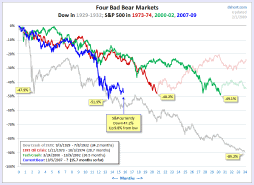Update, 2009-8-25: To gain access to the on-line video of this seminar and the ancillary written material, please visit PrefLetter.com
I am pleased to announce that I will be hosting a seminar series on the theory and practice of preferred share investing.
These seminars will be aimed at active and potential preferred share investors who wish to review relative valuation techniques in preferred share analysis.
All seminars will be presented by James Hymas, who has written extensively on the subject of preferred share investment and has been referred to as a "top expert" on the subject.
Questions are encouraged throughout the seminars, as well as in informal discussion at the end of the session.
Each seminar is two hours in length; coffee and tea will be served. The cost of attendance is $100, but a discount of $50 will be given to participants who have an annual subscription to PrefLetter with at least one issue remaining at the time of the seminar.
PerpetualDiscounts: Theory & Practice
"PerpetualDiscounts" are currently the most common type of preferred share in Canada. They are characterized by:
- No mechanism whereby the issue can be forced to redeem the shares
- A fixed dividend rate
- Call provisions in the issuer’s favour
- a trading price below their call price
This seminar will review the theory of PerpetualDiscount evaluation, including:
- Credit Quality
- The embedded call
- The importance of ex-Dividend dates
- Importance of cumulative dividends
- Investment characteristics relative to bonds
Examples of relative valuation in current markets will be supplied and discussed.
Attendence is limited; a reservation will avoid disappointment.
Location: Days Hotel & Conference Center, (at Carlton & College, downtown Toronto) Yorkville Room (see map).
Time: February 26, 2009, 6pm-8pm.
Reservations: Please send an eMail to jiHymas@himivest.com.
Update, 2009-4-24: The seminar and its ancillary material have been accredited for four hours of IDA Professional Development Continuing Education.

Update, 2009-8-24: ◦This program is eligible for four CE credit hours, as granted by CFA Institute. If you are a CFA Institute member, CE credit for your participation in this program will be automatically recorded in your CE Diary.

